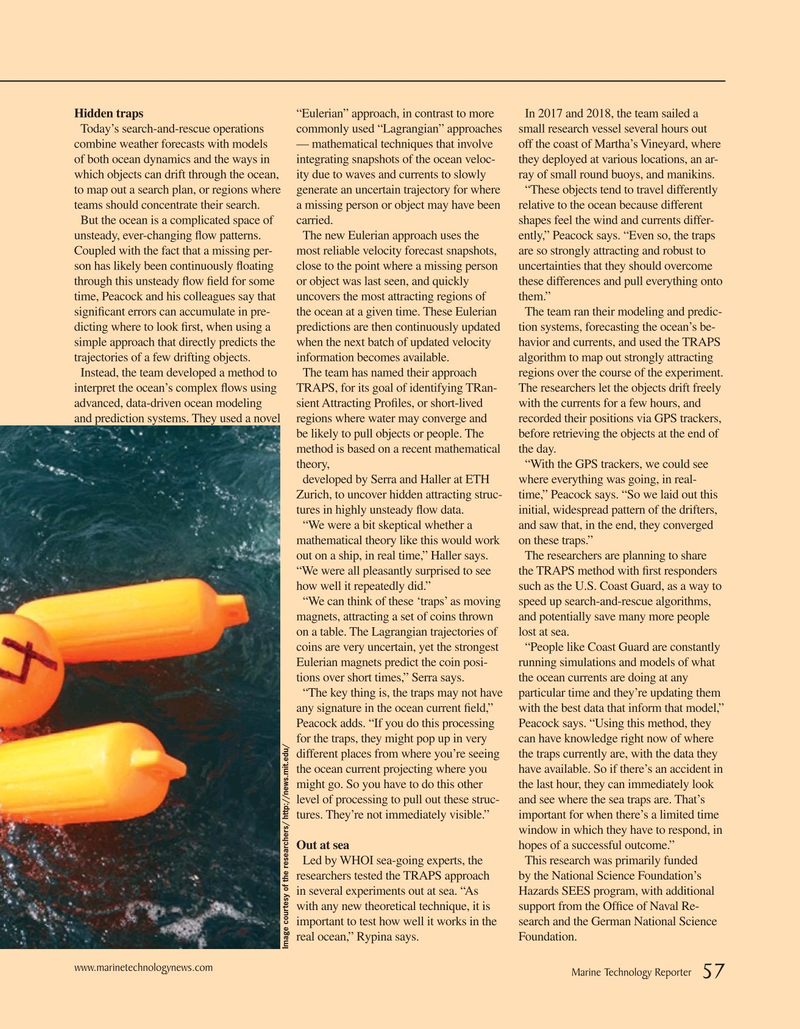
Page 57: of Marine Technology Magazine (June 2020)
Read this page in Pdf, Flash or Html5 edition of June 2020 Marine Technology Magazine
Hidden traps “Eulerian” approach, in contrast to more In 2017 and 2018, the team sailed a
Today’s search-and-rescue operations commonly used “Lagrangian” approaches small research vessel several hours out combine weather forecasts with models — mathematical techniques that involve off the coast of Martha’s Vineyard, where of both ocean dynamics and the ways in integrating snapshots of the ocean veloc- they deployed at various locations, an ar- which objects can drift through the ocean, ity due to waves and currents to slowly ray of small round buoys, and manikins.
to map out a search plan, or regions where generate an uncertain trajectory for where “These objects tend to travel differently teams should concentrate their search. a missing person or object may have been relative to the ocean because different
But the ocean is a complicated space of carried. shapes feel the wind and currents differ- unsteady, ever-changing fow patterns. The new Eulerian approach uses the ently,” Peacock says. “Even so, the traps
Coupled with the fact that a missing per- most reliable velocity forecast snapshots, are so strongly attracting and robust to son has likely been continuously foating close to the point where a missing person uncertainties that they should overcome through this unsteady fow feld for some or object was last seen, and quickly these differences and pull everything onto time, Peacock and his colleagues say that uncovers the most attracting regions of them.” signifcant errors can accumulate in pre- the ocean at a given time. These Eulerian The team ran their modeling and predic- dicting where to look frst, when using a predictions are then continuously updated tion systems, forecasting the ocean’s be- simple approach that directly predicts the when the next batch of updated velocity havior and currents, and used the TRAPS trajectories of a few drifting objects. information becomes available. algorithm to map out strongly attracting
Instead, the team developed a method to The team has named their approach regions over the course of the experiment. interpret the ocean’s complex fows using TRAPS, for its goal of identifying TRan- The researchers let the objects drift freely advanced, data-driven ocean modeling sient Attracting Profles, or short-lived with the currents for a few hours, and and prediction systems. They used a novel regions where water may converge and recorded their positions via GPS trackers, be likely to pull objects or people. The before retrieving the objects at the end of method is based on a recent mathematical the day.
theory, “With the GPS trackers, we could see developed by Serra and Haller at ETH where everything was going, in real-
Zurich, to uncover hidden attracting struc- time,” Peacock says. “So we laid out this tures in highly unsteady fow data. initial, widespread pattern of the drifters, “We were a bit skeptical whether a and saw that, in the end, they converged mathematical theory like this would work on these traps.” out on a ship, in real time,” Haller says. The researchers are planning to share “We were all pleasantly surprised to see the TRAPS method with frst responders how well it repeatedly did.” such as the U.S. Coast Guard, as a way to “We can think of these ‘traps’ as moving speed up search-and-rescue algorithms, magnets, attracting a set of coins thrown and potentially save many more people on a table. The Lagrangian trajectories of lost at sea.
coins are very uncertain, yet the strongest “People like Coast Guard are constantly
Eulerian magnets predict the coin posi- running simulations and models of what tions over short times,” Serra says. the ocean currents are doing at any “The key thing is, the traps may not have particular time and they’re updating them any signature in the ocean current feld,” with the best data that inform that model,”
Peacock adds. “If you do this processing Peacock says. “Using this method, they for the traps, they might pop up in very can have knowledge right now of where different places from where you’re seeing the traps currently are, with the data they the ocean current projecting where you have available. So if there’s an accident in might go. So you have to do this other the last hour, they can immediately look level of processing to pull out these struc- and see where the sea traps are. That’s tures. They’re not immediately visible.” important for when there’s a limited time window in which they have to respond, in
Out at sea hopes of a successful outcome.”
Led by WHOI sea-going experts, the This research was primarily funded researchers tested the TRAPS approach by the National Science Foundation’s in several experiments out at sea. “As Hazards SEES program, with additional with any new theoretical technique, it is support from the Offce of Naval Re- important to test how well it works in the search and the German National Science real ocean,” Rypina says. Foundation.
Image courtesy of the researchers/ http://news.mit.edu/ www.marinetechnologynews.com
Marine Technology Reporter 57

 56
56

 58
58
